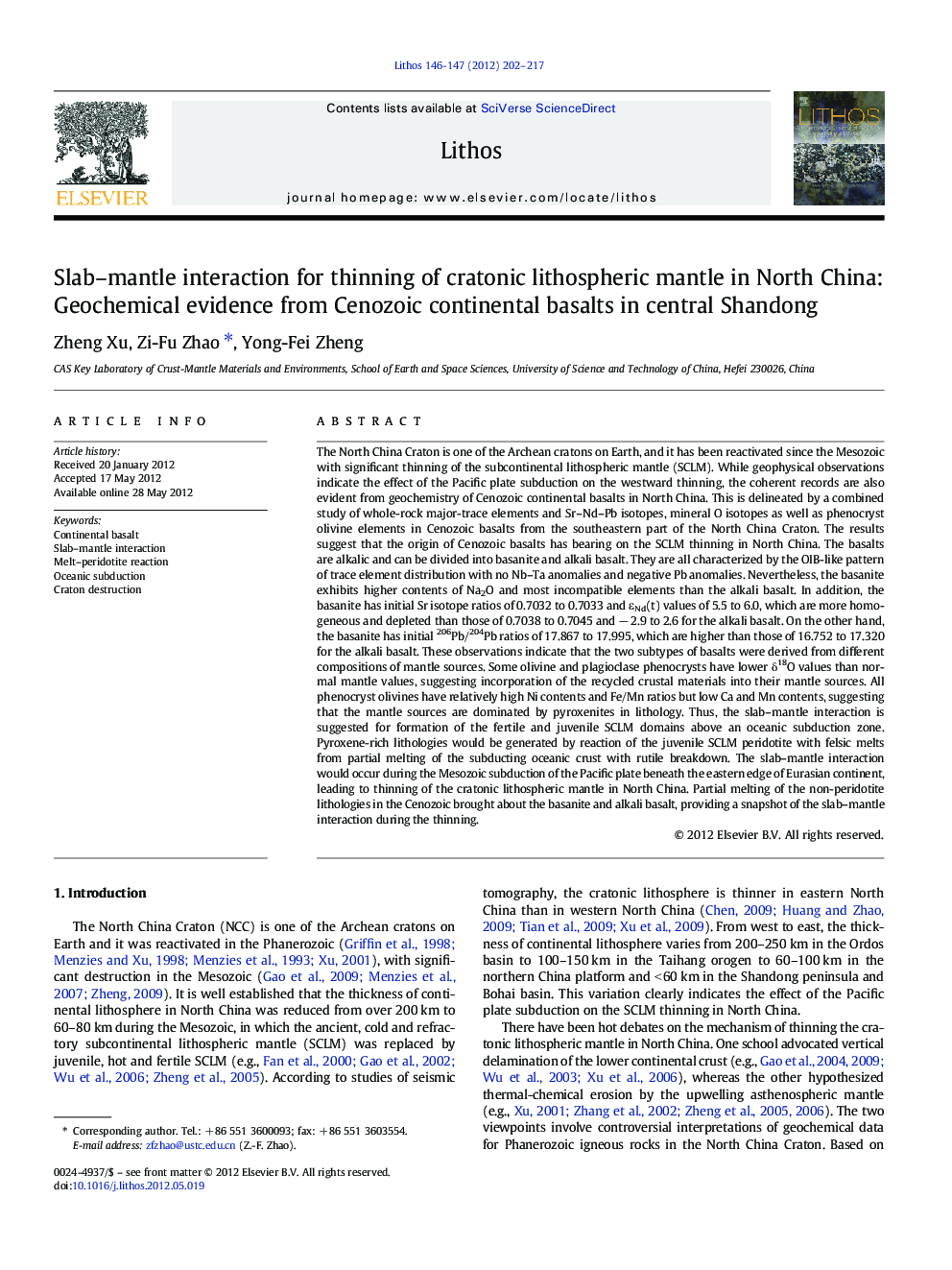| کد مقاله | کد نشریه | سال انتشار | مقاله انگلیسی | نسخه تمام متن |
|---|---|---|---|---|
| 4716521 | 1638706 | 2012 | 16 صفحه PDF | دانلود رایگان |

The North China Craton is one of the Archean cratons on Earth, and it has been reactivated since the Mesozoic with significant thinning of the subcontinental lithospheric mantle (SCLM). While geophysical observations indicate the effect of the Pacific plate subduction on the westward thinning, the coherent records are also evident from geochemistry of Cenozoic continental basalts in North China. This is delineated by a combined study of whole-rock major-trace elements and Sr–Nd–Pb isotopes, mineral O isotopes as well as phenocryst olivine elements in Cenozoic basalts from the southeastern part of the North China Craton. The results suggest that the origin of Cenozoic basalts has bearing on the SCLM thinning in North China. The basalts are alkalic and can be divided into basanite and alkali basalt. They are all characterized by the OIB-like pattern of trace element distribution with no Nb–Ta anomalies and negative Pb anomalies. Nevertheless, the basanite exhibits higher contents of Na2O and most incompatible elements than the alkali basalt. In addition, the basanite has initial Sr isotope ratios of 0.7032 to 0.7033 and εNd(t) values of 5.5 to 6.0, which are more homogeneous and depleted than those of 0.7038 to 0.7045 and − 2.9 to 2.6 for the alkali basalt. On the other hand, the basanite has initial 206Pb/204Pb ratios of 17.867 to 17.995, which are higher than those of 16.752 to 17.320 for the alkali basalt. These observations indicate that the two subtypes of basalts were derived from different compositions of mantle sources. Some olivine and plagioclase phenocrysts have lower δ18O values than normal mantle values, suggesting incorporation of the recycled crustal materials into their mantle sources. All phenocryst olivines have relatively high Ni contents and Fe/Mn ratios but low Ca and Mn contents, suggesting that the mantle sources are dominated by pyroxenites in lithology. Thus, the slab–mantle interaction is suggested for formation of the fertile and juvenile SCLM domains above an oceanic subduction zone. Pyroxene-rich lithologies would be generated by reaction of the juvenile SCLM peridotite with felsic melts from partial melting of the subducting oceanic crust with rutile breakdown. The slab–mantle interaction would occur during the Mesozoic subduction of the Pacific plate beneath the eastern edge of Eurasian continent, leading to thinning of the cratonic lithospheric mantle in North China. Partial melting of the non-peridotite lithologies in the Cenozoic brought about the basanite and alkali basalt, providing a snapshot of the slab–mantle interaction during the thinning.
Tectonic sketches for the origin of Cenozoic continental basalts and its bearing on the SCLM thinning in the eastern part of North China.Figure optionsDownload as PowerPoint slideHighlights
► Major-trace elements and stable-radiogenic isotopes for Cenozoic continental basalts.
► Pyroxene-rich mantle lithologies are suggested for OIB-like continental basalts.
► Reaction of peridotite with melt from subducting oceanic crust with rutile breakdown.
► Slab–mantle interaction is responsible for the formation of juvenile SCLM sources.
► The NCC destruction and SCLM thinning due to subduction erosion of the Pacific plate.
Journal: Lithos - Volumes 146–147, August 2012, Pages 202–217